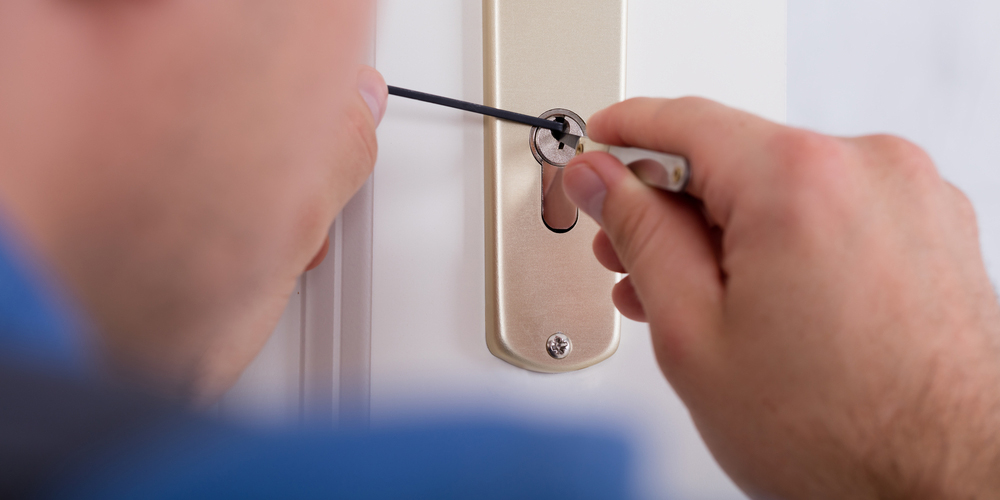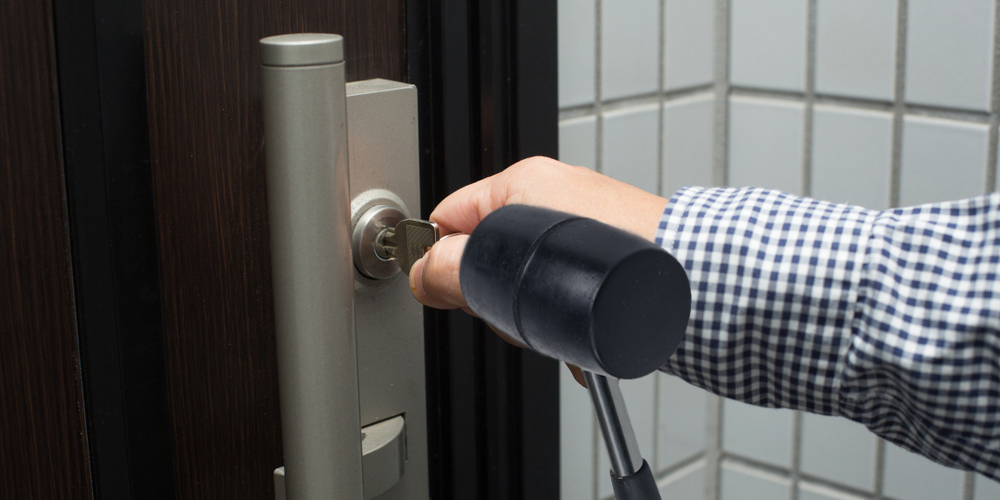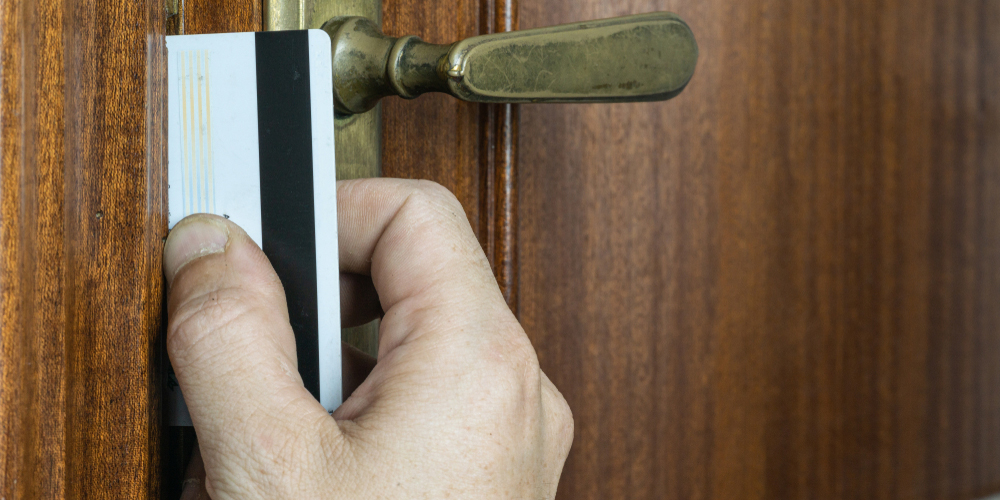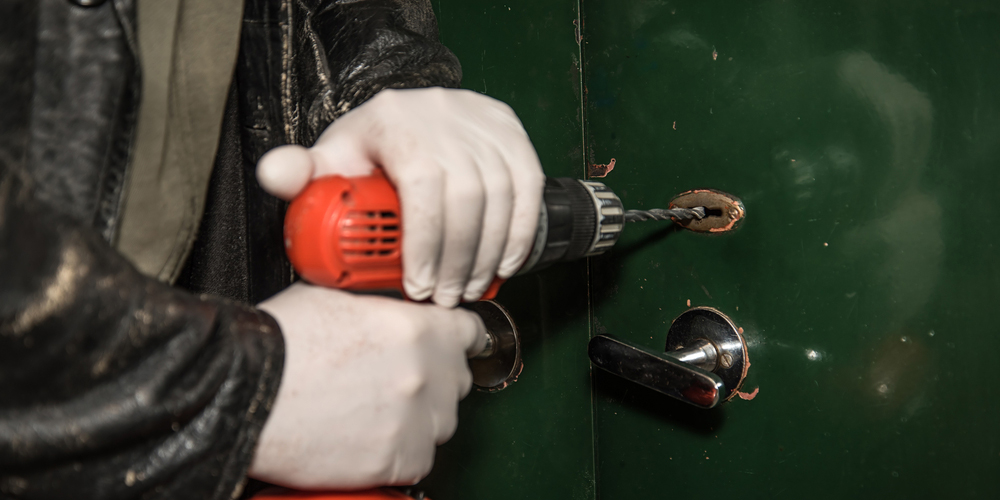Lock Blog
A resource for consumers, locksmiths, and security professionals
A resource for consumers, locksmiths, and security professionals

Knowing how to unlock a door without a key is a nifty little trick that will come in handy many times in your life. For instance, let’s say that you’re locked out of your room because you lost your key or because your key is broken, what do you do next? This is only one of many scenarios in which it helps to know how to unlock a door without a key. Aside from the fact that it is a cool skill to have, you will have learned something meaningful that might lead to fewer home lockouts and office lockouts.
Ways to unlock a door without a key include:
As humans, we are creatures of habit, and habit often makes us complacent. Complacency tends to mean that we start to forget things and adopt a more lax approach to aspects of our daily lives. This means that some homeowners forget to take their house keys with them when they are leaving home, or that some drivers mistakenly lock themselves out of their cars. Bottom line is, stuff happens.
Knowing how to unlock a door without a key helps you stay better prepared for the kind of stuff that just happens. Also, the skills that will help you unlock a door without a lock will help you in other varied situations. For instance, if you happen to be held against your will in a pair of handcuffs or other similar restraints, it helps to know how to circumvent these. Here are the things you can do to unlock a door without a key.
To pick a lock, you must first know the lock. This tenet is emphasized by the guide to lock picking. Essentially, you need to be familiar with the parts of a lock and the way these parts work in conjunction with one another. If someone were to oversimplify the process of lock picking, they would probably say lock picking aims to imitate the function of a working key. All locks can be picked, but that doesn’t mean picking them is going to be an easy task.
Most of the locks that the average person will come across in a residential or commercial setting are pin tumbler locks. However, other locks can be used as well. For instance, mortise locks are extremely popular in commercial settings because of their durability. If you take a look at some of the best front door locks, you will notice that there is a good variety of lock types.
It should be noted that the locking mechanism on car doors is not the traditional pin tumbler lock. Instead, car door locks usually employ wafer locks and sliders. There are more efficient ways to bypass a car door lock, so you won’t find most people picking these locks. Since pin tumbler locks are easier to tackle, explaining lock picking through the perspective of a basic pin tumbler lock works best.
The core components of a basic pin tumbler lock are the key pins, driver pins, springs, plug, and housing. When the appropriate key is inserted, the plug can rotate in the housing. These elements work together to execute the locking and unlocking motion of the lock. The key pins correspond to specific groove cuts on a key, and these are the main elements that are targeted in the attempt to unlock a door without a key via lock picking.
If you want to pick a lock to unlock a door without a key, you will need some basic lock picking tools. There are times when these tools will not be handy and you might have to improvise some lock picking tools. Common examples of improvised lock picking tools are bobby pins and paper clips that can be bent out of shape to fit your lock picking needs. The hook, rake, and tension wrenches are the more traditional and essential lock picking tools and the key to being able to unlock a door without a lock.
The basic pin tumbler lock should work, ideally, with only one key. That is unless you have a master key system in place. So to unlock a door without a key, you will have to imitate the action of the key itself. To accomplish this, you can either make use of raking or single pin picking. These are lock picking methods that will help you unlock a door without a key.
By implementing these methods, the hope is to manipulate the pins that are housed within the locking mechanism. Essentially, by raising the key pins to the shear line and pushing the driver pins above the shear line, a gap is created that facilitates the rotation of the plug (the gap is referred to as the shear line). Once this has been accomplished, you should be able to unlock a door without a key.
It depends on the lock and the quality of your lock picks. The better your lock, the harder it will be to pick. The better your picks, the easier the lock will be to pick. With a cheap lock and good picks, you can rake a lock open with a bit of knowledge and luck. Other than that, you are likely to have trouble picking any lock.
All you need is a way to tension the lock and manipulate the internals simultaneously. Professional tools work better than improvised picks, but both will work. You will need more luck or training if you are using picks made out of paper clips. With professional tools, you can trust that the tool is not the reason you can’t open the lock.
Key Takeaways

When it comes to being able to unlock a door without a key, lock bumping is a method that should be considered. The main caveat with this is that many property owners have actively instituted security measures to prevent lock bumping, so it might not help you if your door locks have some anti-bump features in place. Also, bump keys do not work on cars, so it is not a viable solution for unlocking a car door without a key.
Similar to the way the lock picking method described above makes use of specific tools, lock bumping also has its own unique set of tools that are fairly easy to get a hold of. In this instance, a bump key is required to successfully bump a lock. Key? Aren’t we supposed to be figuring out how to unlock a door without a key? Now, do not be startled by the presence of a key here because a bump key is not a traditional key, which means that you are still technically going to unlock a door without a key.
A bump key is a specially fashioned key that looks to actively exploit the key pins and driver pins inside a pin tumbler lock. The grooves and cuts of the bump key are designed at their maximum depth so that they can be used on multiple locks. However, the key has to at least match the keyway of the lock it is being used on.
To bump a lock, the bump key is inserted into the keyway, and pressure is applied via a hammer or a screwdriver. The pressure exerted on the bump key causes the key pins to push the driver pins above the shear line. At this exact moment, if the right amount of torque is applied, you will be able to unlock a door without a key.
A bump key is not the same as a skeleton key. Skeleton keys have more in common with master keys. Skeleton keys will open a lock just by turning in the keyway (mainly just for warded locks). Bump keys have to be manipulated within the keyway (only for pin tumbler locks).
Bump keys are widely available online, and can even be purchased on sites like Amazon. However, you should consult your local laws surrounding lock picks and bump keys before making any purchases. With these tools being so widely available it is important to take the steps to bump-proof your locks.
Key Takeaways

Using a credit card is another popular lock bypass method that can be used to unlock a door without a key. The term credit card is loosely used to refer to all plastic resin/PVCA solid materials that can be wedged into a door and used to force the lock open. Unlike the methods described above, the tools necessary for this job are very easy to acquire.
However, this process is not effective against deadbolts and high-security locks. It is often used on simple latch locks that are using a slanted latch bolt, but this is only successful if the lock is not paired with a reinforced strike plate. This method aims to target the slanted bolt and forcibly retract the latch that is keeping the door locked in place. It requires the application of a bit of force, which is why it is crucial to make sure the material you are using is sturdy enough.
To properly carry this out, angle your card (or other suitable material) towards the side of the latch bolt that is slanted. This will allow you to push against the latch bolt and pry it loose from the strike plate that it is resting in. While you are pushing the card down against the angled latch, you should simultaneously apply pressure against the weight of the door. This application of pressure helps you push the door open and unlock it.
If the lock opens by turning a handle/knob, chances are it can be opened with a credit card. As long as the latch can be pressed in and bounces back, it can be opened with a card. It can be more difficult to open if you are on the hinged side of the door.
Yes, you will likely damage the card doing this. It is best to use a canceled card or even a used gift card. Do not use a credit card you are worried about damaging.
Key Takeaways

As the name suggests, drilling a lock is a form of destructive entry, which means that if you use this method to unlock a door without a key, your lock will be damaged and rendered ineffective. If this is the case, you will have to acquire new locks and then have them professionally installed.
I do not suggest using this method until you have exhausted all other options. There are several different things you must do before you drill a lock, so do not rush to carry out this action simply because you want to unlock a door without a key.
It is important to be mindful of the fact that drilling a lock is not exactly an easy process, especially if you are unsure of what you are doing. Generally, the process should take a few minutes, but if you do not properly align the drill at the top of the keyway, it can take much longer.
As with all the processes above, there are some tools that you will need to utilize when using this method to unlock a door without a key. To drill a lock you will need an electric or battery-powered drill, an appropriately sized drill bit, lubricant for the lock, and a screwdriver.
This process aims to use brute force to overpower the core of the locking mechanism. Essentially, you need to drill the lock at the shear line in such a way that forcefully separates the driver pins and key pins holding the lock in place. Once this is done, you will be able to rotate the plug and unlock a door without a key.
Many high-security locks use anti-drill technology. This will prevent most criminals and almost all lock owners from being able to drill a lock open. However, locksmiths have the training and insight to open high-security locks with destructive entry.
Yes, the lock will be compromised and must be replaced after drilling. Once a lock is drilled it can be opened easily or can stop opening altogether. For your safety and security, replace the lock immediately.
Key Takeaways
Another way to unlock a door without a key is to simply work on making the door and its accompanying door lock somewhat irrelevant. This can be done in multiple ways. One of the most common ways to accomplish this is to kick the door down or ram it so that the lock is dislodged from the door jamb. Another way to accomplish this is by removing the hinges on a door so that the lock is rendered ineffective.
Ramming a door or kicking it down places a considerable amount of pressure on the lock that is keeping it secure. Pursuing this method will damage your lock to the point where you will require damaged lock repair services from a locksmith. Many people think this is a fair exchange until they realize a broken door lock can be more serious than you think.
Similar to the process of drilling a lock, this method looks to forcefully circumvent your locks. To ram a door, you need to focus your energy on the points that matter. This can either be the door lock or the door hinges. The goal here is to exert enough force that dislodges the lock or the hinges from the door.
On the other hand, the process of removing your hinges is a more subtle way of getting around your locks. There is a smaller chance that your locks will end up damaged, but the process is not entirely foolproof. This method only works on outswing doors where the door hinges are left exposed. Since the hinges are left exposed you can use a flathead screwdriver to remove the hinge pins that are propping the door up. However, be wary of the fact that removing your door hinges places the entire weight of your door on your door lock, which might cause the lock bolt to bend out of shape.
There are a minimal number of tools required to carry out both of these methods, but that is probably offset by the fact that there is a much higher risk. In the grand scheme of things, I would suggest avoiding this last method. Although it might get you back into your room or office in an expedient way, there is a lot more legwork that has to be done afterward.
Most doors can be opened with a single kick. In the case of interior doors, you may kick a hole in the door, so make sure your legs are covered. Be aware that if the door does not fail, you can injure yourself. Only do this in the most time-sensitive emergency situations.
Square up to the door so you would be kicking into the next room if there were no door. Aim at directly parallel to the handle, knob, deadbolt, etc. Kick as though you are trying to strike beyond the door.
Key Takeaways
This might sound a little out of place, especially in comparison to the methods that were described above. However, calling a locksmith is sometimes the best solution to unlocking a door without a key. Some people tend to avoid locksmiths because they are unsure of some of the processes and expectations of calling a locksmith. A locksmith is always there to help you, you simply have to find one you trust and reach out to them for assistance.
In some cases, you will simply need them to unlock a door without a key, while in other cases you might need them to fashion a new key, carry out a broken key extraction, or install a completely new lock. Regardless of the service required, a locksmith will be able to assist you in unlocking a door without a key.
For the most part, a locksmith will attempt to pick or bump your lock, and this usually works. However, if these methods prove unsuccessful, the locksmith will drill your lock to unlock the door without a key, and then subsequently install a new lock for you.
Overall, it is much more efficient to call a locksmith to tackle these problems, rather than attempting each of the above methods yourself, especially if you are not the most DIY savvy homeowner. If price is your concern, taking a look at most standard locksmith prices will show you that in terms of time and money, calling a locksmith is actually one of the cheaper options.
Yes. If you have lost your key or the key has broken, a locksmith can make a new key. A locksmith can make a key from a broken key or decode the lock and make a new key. A locksmith will have options for getting you a new key.
If the lock cannot be picked or bumped, it will need to be opened with some form of destructive entry. This should always be a last resort, reserved for high-security locks and broken locks that cannot be opened even with the right key.
Key Takeaways
Unlocking a door without a key is already a challenging affair, and I would hate for you to tackle this blind. I hope that the points outlined above will help you explore an appropriate solution to your problem, and help you unlock a door without a key. Always be aware of the fact that these solutions should not be abused or exploited. If you are not a locksmith working on a job, only use these procedures on your door locks or door locks that you have been given permission to bypass.
Category: How To's, Residential, Safety & Security